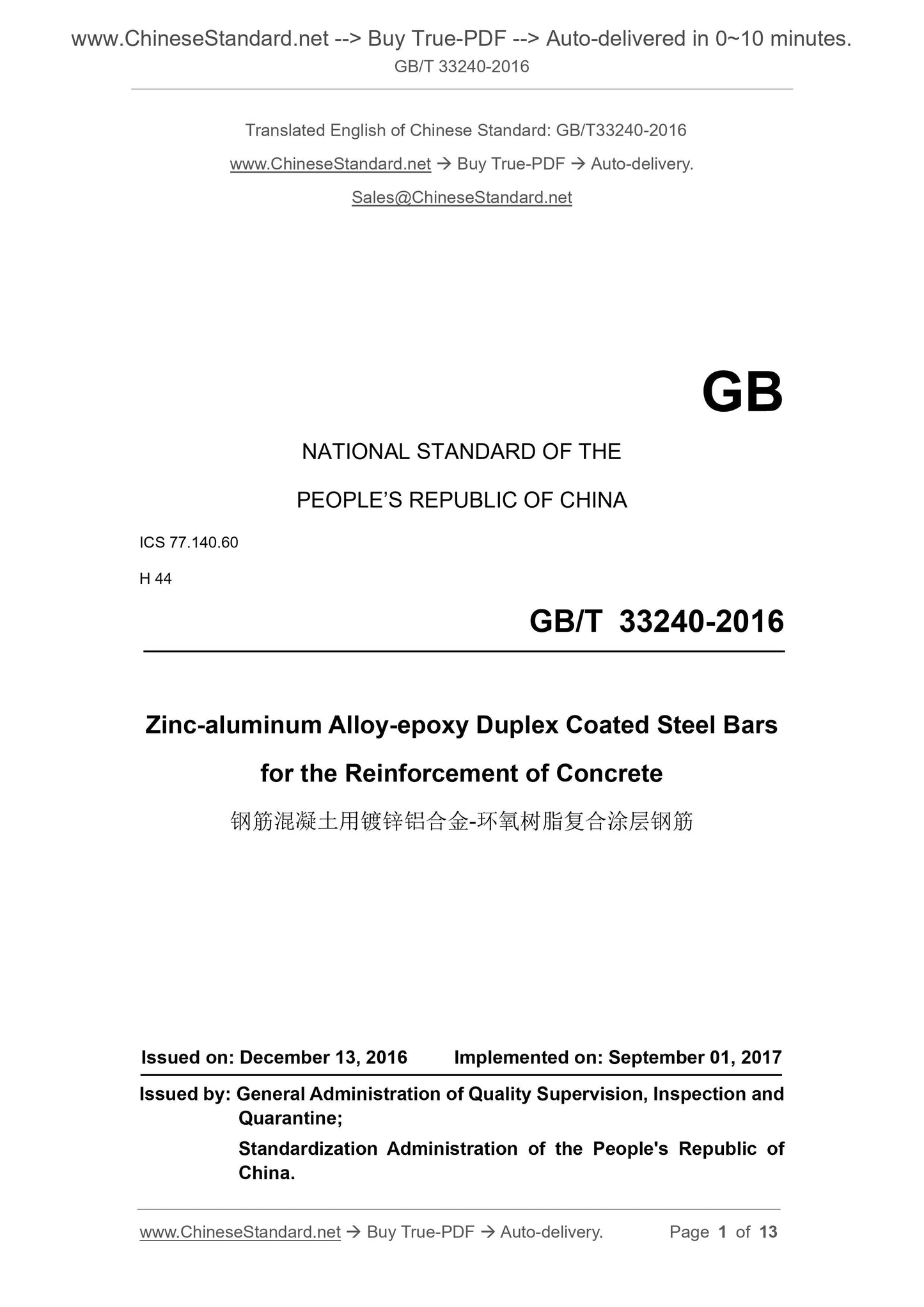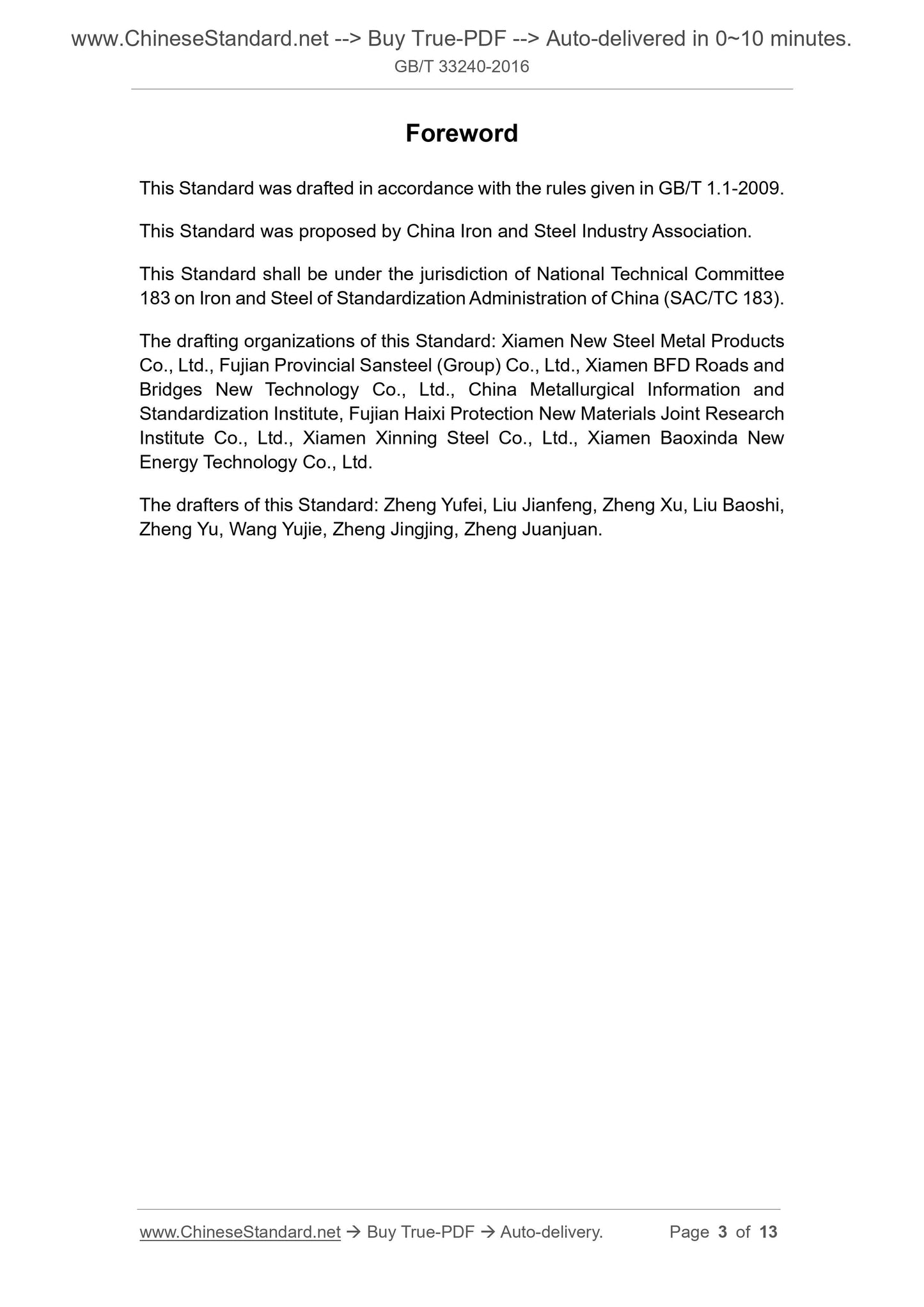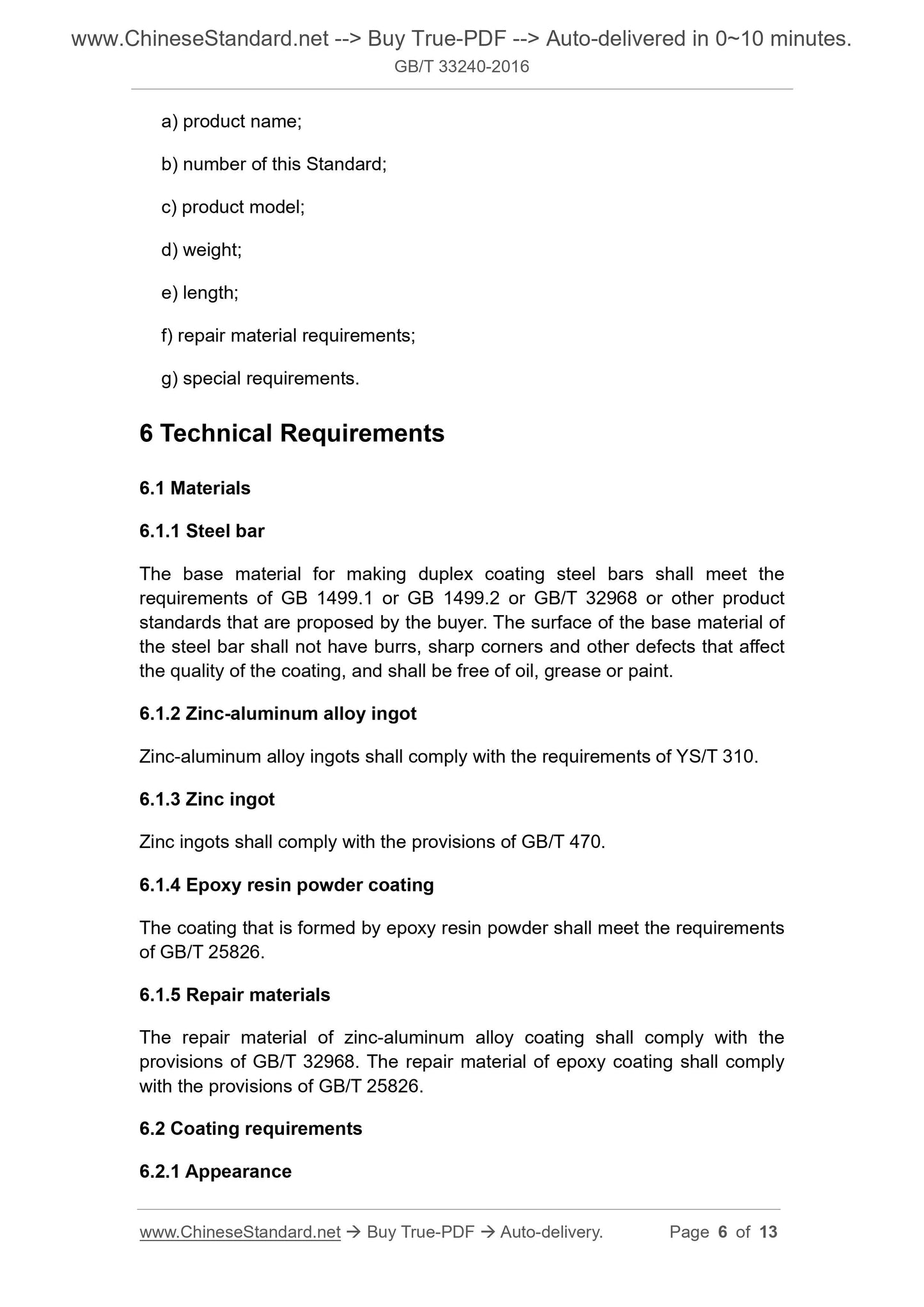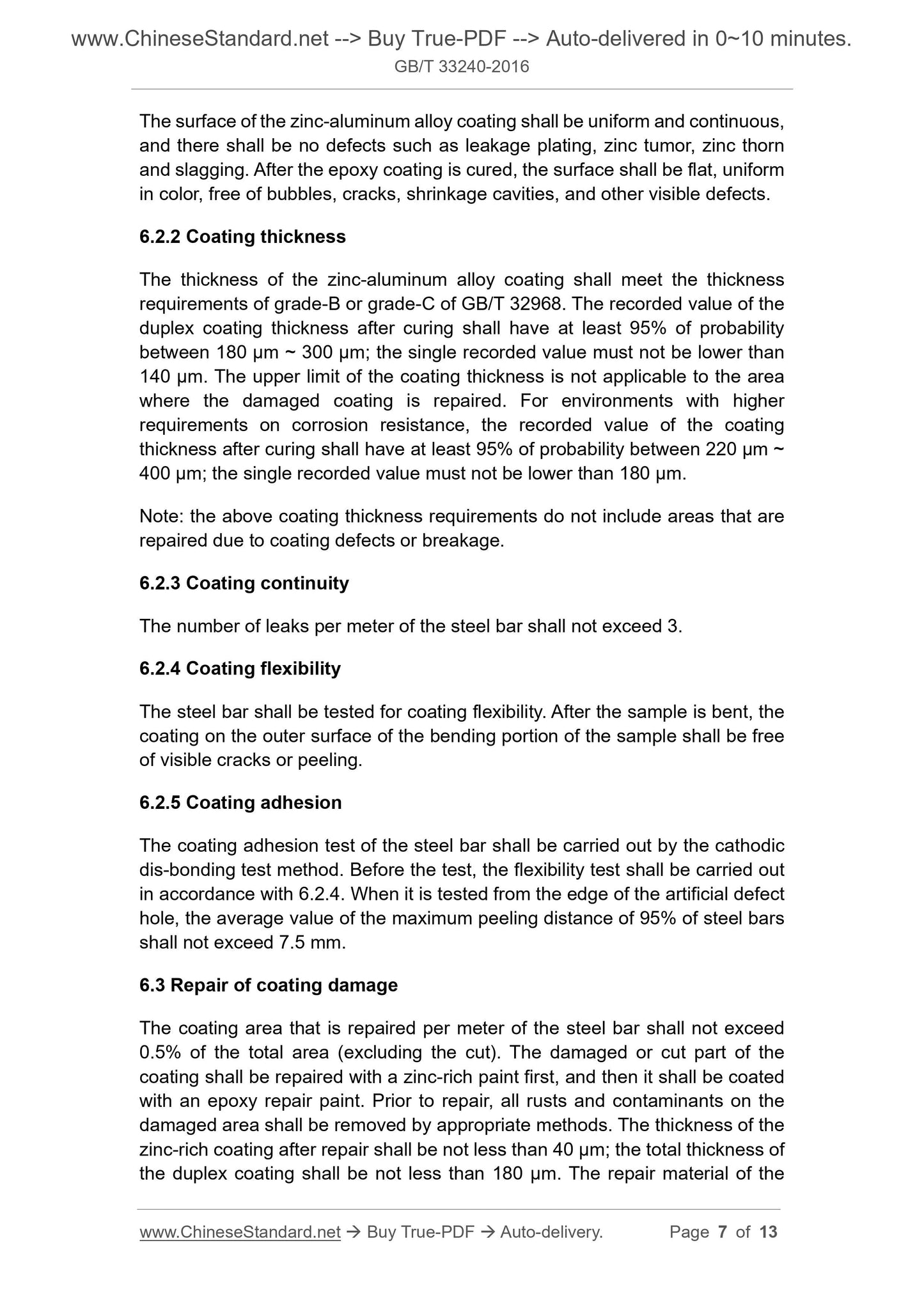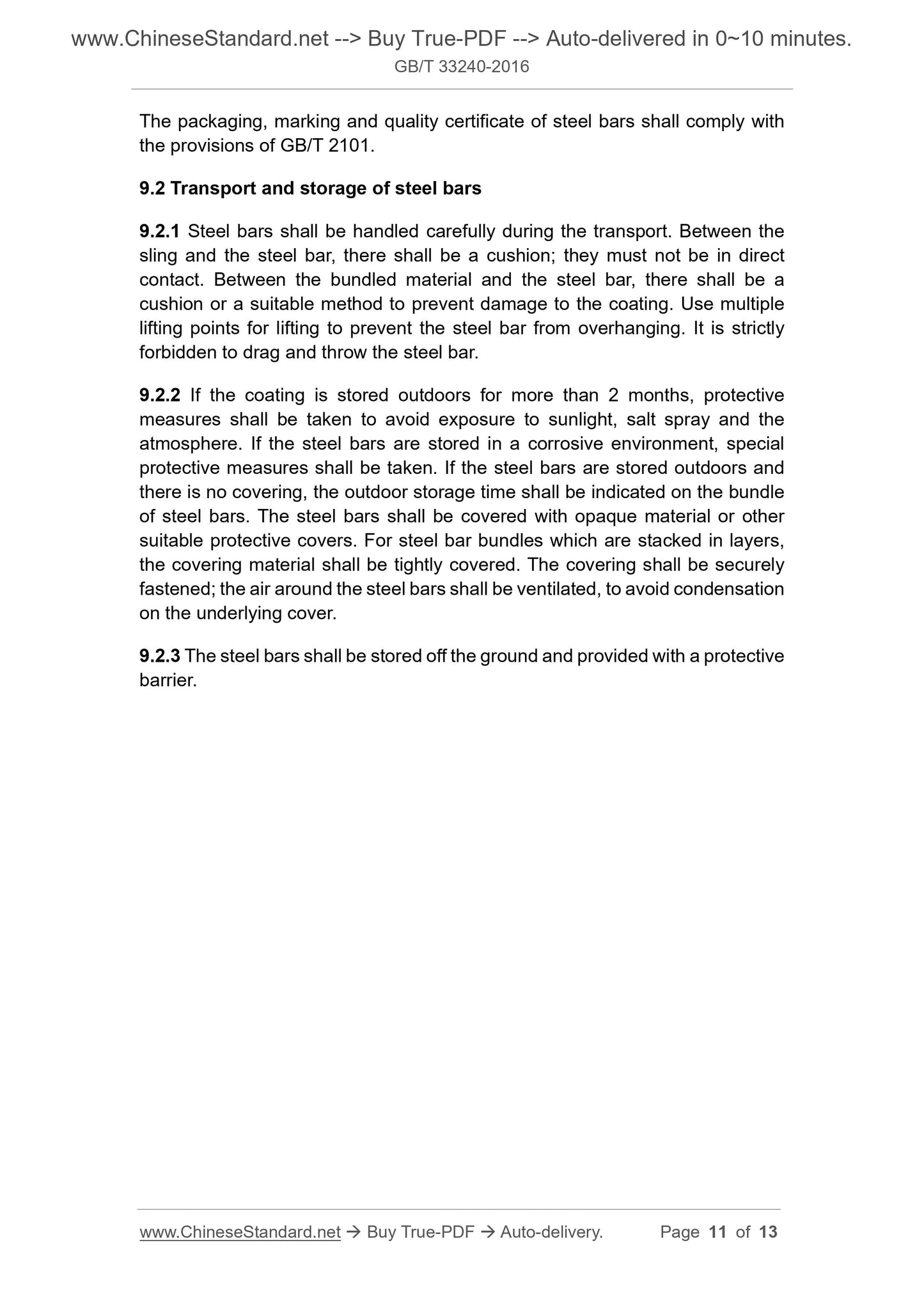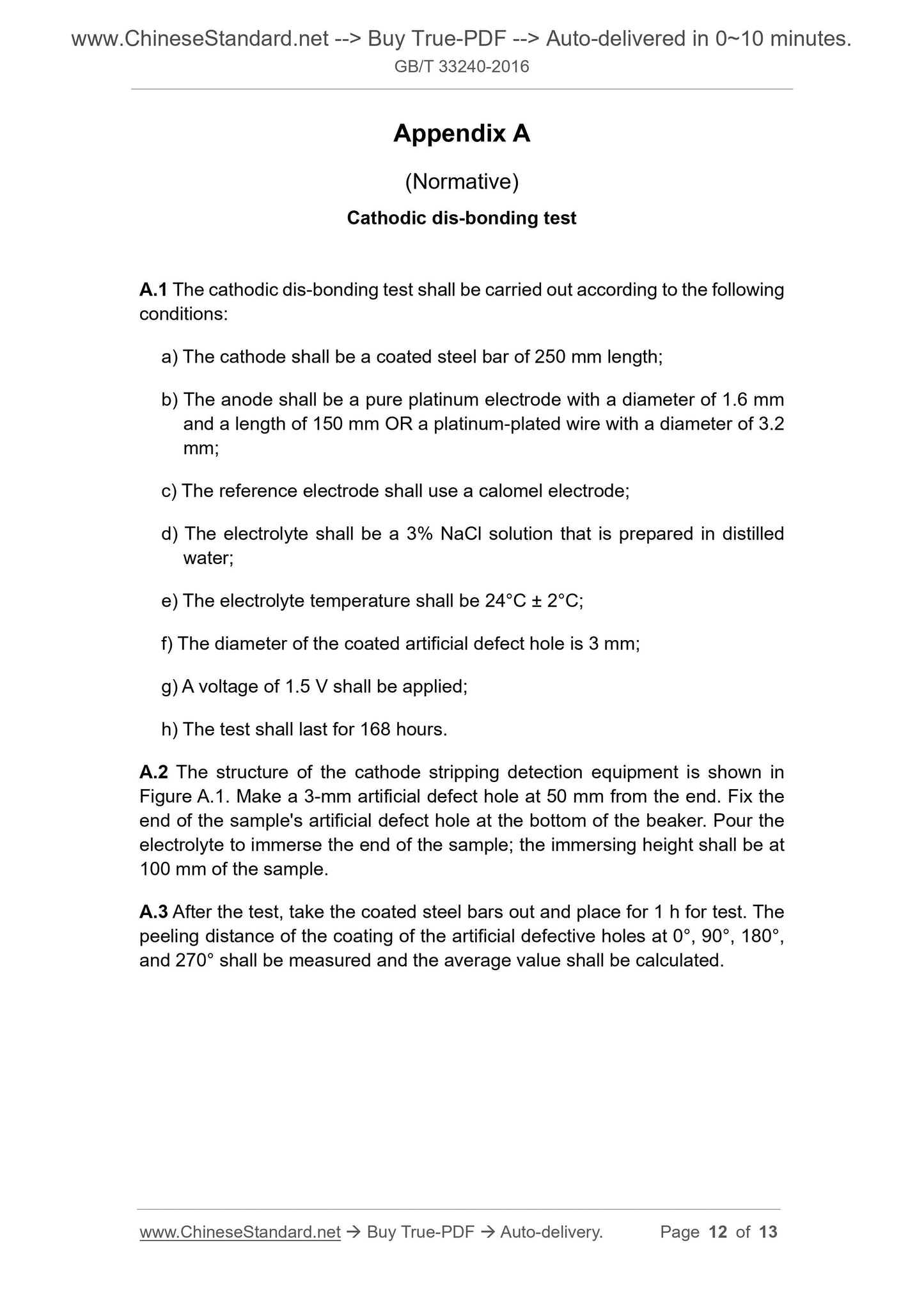1
/
of
12
www.ChineseStandard.us -- Field Test Asia Pte. Ltd.
GB/T 33240-2016 English PDF (GB/T33240-2016)
GB/T 33240-2016 English PDF (GB/T33240-2016)
Regular price
$150.00
Regular price
Sale price
$150.00
Unit price
/
per
Shipping calculated at checkout.
Couldn't load pickup availability
GB/T 33240-2016: Zinc-aluminum Alloy-epoxy Duplex Coated Steel Bars for the Reinforcement of Concrete
Delivery: 9 seconds. Download (& Email) true-PDF + Invoice.
Get Quotation: Click GB/T 33240-2016 (Self-service in 1-minute)
Historical versions (Master-website): GB/T 33240-2016
Preview True-PDF (Reload/Scroll-down if blank)
GB/T 33240-2016
NATIONAL STANDARD OF THE
PEOPLE’S REPUBLIC OF CHINA
ICS 77.140.60
H 44
Zinc-aluminum Alloy-epoxy Duplex Coated Steel Bars
for the Reinforcement of Concrete
ISSUED ON: DECEMBER 13, 2016
IMPLEMENTED ON: SEPTEMBER 01, 2017
Issued by: General Administration of Quality Supervision, Inspection and
Quarantine;
Standardization Administration of the People's Republic of
China.
Table of Contents
Foreword ... 3
1 Scope ... 4
2 Normative references ... 4
3 Terms and definitions ... 5
4 Code and example ... 5
5 Ordering content ... 5
6 Technical Requirements ... 6
7 Test method ... 8
8 Test rules ... 10
9 Packaging, marking, quality certificate, transport and storage ... 10
Appendix A (Normative) Cathodic dis-bonding test ... 12
Foreword
This Standard was drafted in accordance with the rules given in GB/T 1.1-2009.
This Standard was proposed by China Iron and Steel Industry Association.
This Standard shall be under the jurisdiction of National Technical Committee
183 on Iron and Steel of Standardization Administration of China (SAC/TC 183).
The drafting organizations of this Standard: Xiamen New Steel Metal Products
Co., Ltd., Fujian Provincial Sansteel (Group) Co., Ltd., Xiamen BFD Roads and
Bridges New Technology Co., Ltd., China Metallurgical Information and
Standardization Institute, Fujian Haixi Protection New Materials Joint Research
Institute Co., Ltd., Xiamen Xinning Steel Co., Ltd., Xiamen Baoxinda New
Energy Technology Co., Ltd.
The drafters of this Standard: Zheng Yufei, Liu Jianfeng, Zheng Xu, Liu Baoshi,
Zheng Yu, Wang Yujie, Zheng Jingjing, Zheng Juanjuan.
Zinc-aluminum Alloy-epoxy Duplex Coated Steel Bars
for the Reinforcement of Concrete
1 Scope
This Standard specifies the terms and definitions, classification and code, order
content, technical requirements, test methods, inspection rules, packaging,
marking, quality certificate, transport and storage of zinc-aluminum alloy-epoxy
duplex coated steel bars.
This Standard applies to zinc-aluminum alloy-epoxy duplex coated steel bars
and reinforced round bars for the reinforcement of concrete (hereinafter
referred to as steel bars). The zinc-aluminum alloy coating shall be produced
by continuous hot dip coating; the epoxy coating shall be produced by
electrostatic spraying.
2 Normative references
The following documents are indispensable for the application of this document.
For dated references, only the dated version applies to this document. For
undated references, the latest edition (including all amendments) applies to this
document.
GB/T 470, Zinc ingots
GB 1499.1, Steel for the reinforcement of concrete. Part 1: Hot rolled plain
bars
GB 1499.2, Steel for the reinforcement of concrete. Part 2: Hot rolled ribbed
bars
GB/T 2101, General requirement of acceptance, packaging, marking and
certification for section steel
GB/T 4956, Non-magnetic coatings on magnetic substrates - Measurement
of coating thickness - Magnetic method
GB/T 25826, Epoxy-coated steel for the reinforcement of concrete
GB/T 50152, Standard for test method of concrete structures
GB/T 32968, Zinc-aluminum alloy coated steel bars for the reinforcement of
concrete
YB/T 081, Rule for rounding off of numeric values and judgment of testing
values for technical standards of metallurgy
YS/T 310, Zinc alloy ingot for hot dip galvanizing
3 Terms and definitions
Terms and definitions determined by GB/T 32968, GB/T 25826 and the
following ones are applicable to this document.
3.1 Duplex coating
On the clean metal surface, firstly perform continuous hot dipping zinc-
aluminum alloy; then, coat a coating that is obtained from epoxy resin.
3.2 Fusion-bonded epoxy coating
Spray on a heated clean metal surface in powder form to form a continuous
coating after curing. The coating contains a thermosetting epoxy resin, a curing
agent, a pigment, and other additives.
4 Code and example
4.1 Code
The duplex coating steel is coded as ZEDR (the first letters of the words of Zinc-
aluminum, Epoxy, Duplex, Reinforcement).
4.2 Model and example
The model of the duplex coating steel consists of the code number, the steel
grade and the nominal diameter of the steel, and the plating grade.
Example:
For the duplex steel bar, of which the nominal diameter is 20 mm, the grade is
HRB400 hot-rolled ribbed steel bar and the zinc-aluminum alloy coating, the
level is level-B, its product model is “ZEDR·HRB400-20B”.
5 Ordering content
Contracts which order under this Standard shall include the following main
contents:
a) product name;
b) number of this Standard;
c) product model;
d) weight;
e) length;
f) repair material requirements;
g) special requirements.
6 Technical Requirements
6.1 Materials
6.1.1 Steel bar
The base material for making duplex coating steel bars shall meet the
requirements of GB 1499.1 or GB 1499.2 or GB/T 32968 or other product
standards that are proposed by the buyer. The surface of the base material of
the steel bar shall not have burrs, sharp corners and other defects that affect
the quality of the coating, and shall be free of oil, grease or paint.
6.1.2 Zinc-aluminum alloy ingot
Zinc-aluminum alloy ingots shall comply with the requirements of YS/T 310.
6.1.3 Zinc ingot
Zinc ingots shall comply with the provisions of GB/T 470.
6.1.4 Epoxy resin powder coating
The coating that is formed by epoxy resin powder shall meet the requirements
of GB/T 25826.
6.1.5 Repair materials
The repair material of zinc-aluminum alloy coating shall comply with the
provisions of GB/T 32968. The repair material of epoxy coating shall comply
with the provisions of GB/T 25826.
6.2 Coating requirements
6.2.1 Appearance
The surface of the zinc-aluminum alloy coating shall be uniform and continuous,
and there shall be no defects such as leakage plating, zinc tumor, zinc thorn
and slagging. After the epoxy coating is cured, the surface shall be flat, uniform
in color, free of bubbles, cracks, shrinkage cavities, and other visible defects.
6.2.2 Coating thickness
The thickness of the zinc-aluminum alloy coating shall meet the thickness
requirements of grade-B or grade-C of GB/T 32968. The recorded value of the
duplex coating thickness after curing shall have at least 95% of probability
between 180 μm ~ 300 μm; the single recorded value must not be lower than
140 μm. The upper limit of the coating thickness is not applicable to the area
where the damaged coating is repaired. For environments with higher
requirements on corrosion resistance, the recorded value of the coating
thickness after curing shall have at least 95% of probability between 220 μm ~
400 μm; the single recorded value must not be lower than 180 μm.
Note: the above coating thickness requirements do not include areas that are
repaired due to coating defects or breakage.
6.2.3 Coating continuity
The number of leaks per meter of the steel bar shall not exceed 3.
6.2.4 Coating flexibility
The steel bar shall be tested for coating flexibility. After the sample is bent, the
coating on the outer surface of the bending portion of the sample shall be free
of visible cracks or peeling.
6.2.5 Coating adhesion
The coating adhesion test of the steel bar shall be carried out by the cathodic
dis-bonding test method. Before the test, the flexibility test shall be carried out
in accordance with 6.2.4. When it is tested from the edge of the artificial defect
hole, the average value of the maximum peeling distance of 95% of steel bars
shall not exceed 7.5 mm.
6.3 Repair of coating damage
The coating area that is repaired per meter of the steel bar shall not exceed
0.5% of the total area (excluding the cut). The damaged or cut part of the
coating shall be repaired with a zinc-rich paint first, and then it shall be coated
with an epoxy repair paint. Prior to repair, all rusts and contaminants on the
damaged area shall be removed by appropriate methods. The thickness of the
zinc-rich coating after repair shall be not less than 40 μm; the total thickness of
the duplex coating shall be not less than 180 μm. The repair material of the
damaged coating shall comply with the provisions of 6.1.5.
6.4 Duplex coating steel site construction application guide
For the duplex coating steel site construction application guide, refer to GB/T
25826.
7 Test method
7.1 Inspection items
7.1.1 The inspection items, sampling method, sampling portion and test
methods of each batch of steel bars shall comply with the requirements of Table
1.
Table 1 -- Inspection items, sampling method, sampling portion and test
methods
Serial
No. Inspection items
a Sampling quantity / piece Sampling portion Test method
1 Total coating thickness 3 Different steel bars 7.3, GB/T 4956
2 Coating continuity 3 Different steel bars 7.4
3 Coating flexibility 3 Different steel bars 7.5
4 Coating adhesion 3 Different steel bars 7.6
5 Appearance Piece by piece - 7.2
a The mechanical properties, bending properties and anti-bending properties of the steel bars
after plating shall meet the requirements of GB 1499.2 and GB 1499.1. These items shall
be tested as necessary.
7.1.2 For chemical resistance, cathodic dis-bonding, salt spray test, chloride
permeability, bond strength, wear resistance and impact test, perform type
inspection only, that is, perform inspection only when there are major changes
in raw materials, production processes and equipment and when new products
are produced and suspended products are resumed. The bond strength test
shall be in accordance with the relevant provisions of GB 50152; the bond
strength of the steel bar shall not be less than 85% of the bond strength of the
uncoated steel bar. The cathodic dis-bonding test is carried out in accordance
with Appendix A. Chemical resistance, salt spray test, chloride permeability,
wear resistance and impact test are carried out in accordance with the
provisions of GB/T 25826.
7.2 Appearance
Use corrected vision to visually inspect under normal lighting conditions.
7.3 Thickness
Measure and record the total thickness of the duplex coating according to the
method of GB/T 4956. Measurements shall be made on opposite sides of the
steel bar. For each side, at least 5 measuring points shall be taken evenly over
its full length; the coating thickness of each measuring point shall be the
average value of thickness measurement values of any 3 points within ±3 cm
of the measuring point position. For ribbed steel bars, the measuring point shall
be taken between their ribs. It is as shown in Figure 1.
in millimeters
Note: when it is necessary to separately measure the thickness of the zinc-
aluminum alloy layer or the epoxy coating layer, the cross-section method or
the like can be used for the measurement.
Figure 1 -- Schematic diagram of coating thickness measurement
7.4 Coating continuity
Before delivery, use a wet-sponge DC leak detector with a voltage of not less
than 67.5 V and a resistance of not less than 80 kΩ or equivalent methods to
perform the detection according to the instructions of the leak detector.
7.5 Coating flexibility
The coating flexibility shall be checked by a bending tester. The test sample
shall be in a thermal equilibrium state between 23°C ± 5°C. The mandrel of the
bending machine shall be covered with a special nylon sleeve. The test shall
be bent at a uniform rate of not less than 8 r/min. For ribbed bars, the two
longitudinal ribs of the test sample shall be placed in a plane perpendicular to
the mandrel radius of the bending tester. Mandrel diameter and bending angle
shall be in accordance with Table 2. For the coating steel with higher
requirements of the bending properties, it shall be negotiated between the
supplier and the buyer.
a) ribbed steel bar coating thickness measurement b) plain bar coating thickness measurement
Thickness of point A Thickness of point A
Table 2 -- Coating flexibility test
Nominal diameter d/mm Mandrel diameter / mm Bending angle / (°)
Ribbed bar
d ≤ 20 6d 180
20 < d ≤ 36 8d 180
d > 36 8d 90
Plain bar 6 ~ 22 6d 180
7.6 Coating adhesion
The cathodic dis-bonding test is carried out in accordance with the provisions
of Appendix A.
8 Test rules
8.1 Inspection and acceptance
The inspection and acceptance of steel bars shall be carried out by the
supplier's quality supervision department.
8.2 Batch rules
The steel bars shall be inspected and accepted in batches. Each batch shall
consist of steel bars of the same heat number, the same grade, the same
nominal diameter and the same plating grade. The weight of each batch is not
more than 60 t.
8.3 Inspection items and sampling quantity
The inspection items and sampling quantity of the steel bars shall comply with
the requirements of Table 1.
8.4 Re-inspection and determination
The re-inspection and determination of steel bars shall comply with the
provisions of GB/T 2101.
8.5 Numerical rounding
The numerical rounding of the inspection and inspection result shall be in
accordance with YB/T 081.
9 Packaging, marking, quality certificate, transport and
storage
9.1 Packaging, marking and quality certificate
The packaging, marking and quality certificate of steel bars shall comply with
the provisions of GB/T 2101.
9.2 Transport and storage of steel bars
9.2.1 Steel bars shall be handled carefully during the transport. Between the
sling and the steel bar, there shall be a cushion; they must not be in direct
contact. Between the bundled material and the steel bar, there shall be a
cushion or a suitable method to prevent damage to the coating. Use multiple
lifting points for lifting to prevent the steel bar from overhanging. It is strictly
forbidden to drag and throw the steel bar.
9.2.2 If the coating is stored outdoors for more than 2 months, protective
measures shall...
Delivery: 9 seconds. Download (& Email) true-PDF + Invoice.
Get Quotation: Click GB/T 33240-2016 (Self-service in 1-minute)
Historical versions (Master-website): GB/T 33240-2016
Preview True-PDF (Reload/Scroll-down if blank)
GB/T 33240-2016
NATIONAL STANDARD OF THE
PEOPLE’S REPUBLIC OF CHINA
ICS 77.140.60
H 44
Zinc-aluminum Alloy-epoxy Duplex Coated Steel Bars
for the Reinforcement of Concrete
ISSUED ON: DECEMBER 13, 2016
IMPLEMENTED ON: SEPTEMBER 01, 2017
Issued by: General Administration of Quality Supervision, Inspection and
Quarantine;
Standardization Administration of the People's Republic of
China.
Table of Contents
Foreword ... 3
1 Scope ... 4
2 Normative references ... 4
3 Terms and definitions ... 5
4 Code and example ... 5
5 Ordering content ... 5
6 Technical Requirements ... 6
7 Test method ... 8
8 Test rules ... 10
9 Packaging, marking, quality certificate, transport and storage ... 10
Appendix A (Normative) Cathodic dis-bonding test ... 12
Foreword
This Standard was drafted in accordance with the rules given in GB/T 1.1-2009.
This Standard was proposed by China Iron and Steel Industry Association.
This Standard shall be under the jurisdiction of National Technical Committee
183 on Iron and Steel of Standardization Administration of China (SAC/TC 183).
The drafting organizations of this Standard: Xiamen New Steel Metal Products
Co., Ltd., Fujian Provincial Sansteel (Group) Co., Ltd., Xiamen BFD Roads and
Bridges New Technology Co., Ltd., China Metallurgical Information and
Standardization Institute, Fujian Haixi Protection New Materials Joint Research
Institute Co., Ltd., Xiamen Xinning Steel Co., Ltd., Xiamen Baoxinda New
Energy Technology Co., Ltd.
The drafters of this Standard: Zheng Yufei, Liu Jianfeng, Zheng Xu, Liu Baoshi,
Zheng Yu, Wang Yujie, Zheng Jingjing, Zheng Juanjuan.
Zinc-aluminum Alloy-epoxy Duplex Coated Steel Bars
for the Reinforcement of Concrete
1 Scope
This Standard specifies the terms and definitions, classification and code, order
content, technical requirements, test methods, inspection rules, packaging,
marking, quality certificate, transport and storage of zinc-aluminum alloy-epoxy
duplex coated steel bars.
This Standard applies to zinc-aluminum alloy-epoxy duplex coated steel bars
and reinforced round bars for the reinforcement of concrete (hereinafter
referred to as steel bars). The zinc-aluminum alloy coating shall be produced
by continuous hot dip coating; the epoxy coating shall be produced by
electrostatic spraying.
2 Normative references
The following documents are indispensable for the application of this document.
For dated references, only the dated version applies to this document. For
undated references, the latest edition (including all amendments) applies to this
document.
GB/T 470, Zinc ingots
GB 1499.1, Steel for the reinforcement of concrete. Part 1: Hot rolled plain
bars
GB 1499.2, Steel for the reinforcement of concrete. Part 2: Hot rolled ribbed
bars
GB/T 2101, General requirement of acceptance, packaging, marking and
certification for section steel
GB/T 4956, Non-magnetic coatings on magnetic substrates - Measurement
of coating thickness - Magnetic method
GB/T 25826, Epoxy-coated steel for the reinforcement of concrete
GB/T 50152, Standard for test method of concrete structures
GB/T 32968, Zinc-aluminum alloy coated steel bars for the reinforcement of
concrete
YB/T 081, Rule for rounding off of numeric values and judgment of testing
values for technical standards of metallurgy
YS/T 310, Zinc alloy ingot for hot dip galvanizing
3 Terms and definitions
Terms and definitions determined by GB/T 32968, GB/T 25826 and the
following ones are applicable to this document.
3.1 Duplex coating
On the clean metal surface, firstly perform continuous hot dipping zinc-
aluminum alloy; then, coat a coating that is obtained from epoxy resin.
3.2 Fusion-bonded epoxy coating
Spray on a heated clean metal surface in powder form to form a continuous
coating after curing. The coating contains a thermosetting epoxy resin, a curing
agent, a pigment, and other additives.
4 Code and example
4.1 Code
The duplex coating steel is coded as ZEDR (the first letters of the words of Zinc-
aluminum, Epoxy, Duplex, Reinforcement).
4.2 Model and example
The model of the duplex coating steel consists of the code number, the steel
grade and the nominal diameter of the steel, and the plating grade.
Example:
For the duplex steel bar, of which the nominal diameter is 20 mm, the grade is
HRB400 hot-rolled ribbed steel bar and the zinc-aluminum alloy coating, the
level is level-B, its product model is “ZEDR·HRB400-20B”.
5 Ordering content
Contracts which order under this Standard shall include the following main
contents:
a) product name;
b) number of this Standard;
c) product model;
d) weight;
e) length;
f) repair material requirements;
g) special requirements.
6 Technical Requirements
6.1 Materials
6.1.1 Steel bar
The base material for making duplex coating steel bars shall meet the
requirements of GB 1499.1 or GB 1499.2 or GB/T 32968 or other product
standards that are proposed by the buyer. The surface of the base material of
the steel bar shall not have burrs, sharp corners and other defects that affect
the quality of the coating, and shall be free of oil, grease or paint.
6.1.2 Zinc-aluminum alloy ingot
Zinc-aluminum alloy ingots shall comply with the requirements of YS/T 310.
6.1.3 Zinc ingot
Zinc ingots shall comply with the provisions of GB/T 470.
6.1.4 Epoxy resin powder coating
The coating that is formed by epoxy resin powder shall meet the requirements
of GB/T 25826.
6.1.5 Repair materials
The repair material of zinc-aluminum alloy coating shall comply with the
provisions of GB/T 32968. The repair material of epoxy coating shall comply
with the provisions of GB/T 25826.
6.2 Coating requirements
6.2.1 Appearance
The surface of the zinc-aluminum alloy coating shall be uniform and continuous,
and there shall be no defects such as leakage plating, zinc tumor, zinc thorn
and slagging. After the epoxy coating is cured, the surface shall be flat, uniform
in color, free of bubbles, cracks, shrinkage cavities, and other visible defects.
6.2.2 Coating thickness
The thickness of the zinc-aluminum alloy coating shall meet the thickness
requirements of grade-B or grade-C of GB/T 32968. The recorded value of the
duplex coating thickness after curing shall have at least 95% of probability
between 180 μm ~ 300 μm; the single recorded value must not be lower than
140 μm. The upper limit of the coating thickness is not applicable to the area
where the damaged coating is repaired. For environments with higher
requirements on corrosion resistance, the recorded value of the coating
thickness after curing shall have at least 95% of probability between 220 μm ~
400 μm; the single recorded value must not be lower than 180 μm.
Note: the above coating thickness requirements do not include areas that are
repaired due to coating defects or breakage.
6.2.3 Coating continuity
The number of leaks per meter of the steel bar shall not exceed 3.
6.2.4 Coating flexibility
The steel bar shall be tested for coating flexibility. After the sample is bent, the
coating on the outer surface of the bending portion of the sample shall be free
of visible cracks or peeling.
6.2.5 Coating adhesion
The coating adhesion test of the steel bar shall be carried out by the cathodic
dis-bonding test method. Before the test, the flexibility test shall be carried out
in accordance with 6.2.4. When it is tested from the edge of the artificial defect
hole, the average value of the maximum peeling distance of 95% of steel bars
shall not exceed 7.5 mm.
6.3 Repair of coating damage
The coating area that is repaired per meter of the steel bar shall not exceed
0.5% of the total area (excluding the cut). The damaged or cut part of the
coating shall be repaired with a zinc-rich paint first, and then it shall be coated
with an epoxy repair paint. Prior to repair, all rusts and contaminants on the
damaged area shall be removed by appropriate methods. The thickness of the
zinc-rich coating after repair shall be not less than 40 μm; the total thickness of
the duplex coating shall be not less than 180 μm. The repair material of the
damaged coating shall comply with the provisions of 6.1.5.
6.4 Duplex coating steel site construction application guide
For the duplex coating steel site construction application guide, refer to GB/T
25826.
7 Test method
7.1 Inspection items
7.1.1 The inspection items, sampling method, sampling portion and test
methods of each batch of steel bars shall comply with the requirements of Table
1.
Table 1 -- Inspection items, sampling method, sampling portion and test
methods
Serial
No. Inspection items
a Sampling quantity / piece Sampling portion Test method
1 Total coating thickness 3 Different steel bars 7.3, GB/T 4956
2 Coating continuity 3 Different steel bars 7.4
3 Coating flexibility 3 Different steel bars 7.5
4 Coating adhesion 3 Different steel bars 7.6
5 Appearance Piece by piece - 7.2
a The mechanical properties, bending properties and anti-bending properties of the steel bars
after plating shall meet the requirements of GB 1499.2 and GB 1499.1. These items shall
be tested as necessary.
7.1.2 For chemical resistance, cathodic dis-bonding, salt spray test, chloride
permeability, bond strength, wear resistance and impact test, perform type
inspection only, that is, perform inspection only when there are major changes
in raw materials, production processes and equipment and when new products
are produced and suspended products are resumed. The bond strength test
shall be in accordance with the relevant provisions of GB 50152; the bond
strength of the steel bar shall not be less than 85% of the bond strength of the
uncoated steel bar. The cathodic dis-bonding test is carried out in accordance
with Appendix A. Chemical resistance, salt spray test, chloride permeability,
wear resistance and impact test are carried out in accordance with the
provisions of GB/T 25826.
7.2 Appearance
Use corrected vision to visually inspect under normal lighting conditions.
7.3 Thickness
Measure and record the total thickness of the duplex coating according to the
method of GB/T 4956. Measurements shall be made on opposite sides of the
steel bar. For each side, at least 5 measuring points shall be taken evenly over
its full length; the coating thickness of each measuring point shall be the
average value of thickness measurement values of any 3 points within ±3 cm
of the measuring point position. For ribbed steel bars, the measuring point shall
be taken between their ribs. It is as shown in Figure 1.
in millimeters
Note: when it is necessary to separately measure the thickness of the zinc-
aluminum alloy layer or the epoxy coating layer, the cross-section method or
the like can be used for the measurement.
Figure 1 -- Schematic diagram of coating thickness measurement
7.4 Coating continuity
Before delivery, use a wet-sponge DC leak detector with a voltage of not less
than 67.5 V and a resistance of not less than 80 kΩ or equivalent methods to
perform the detection according to the instructions of the leak detector.
7.5 Coating flexibility
The coating flexibility shall be checked by a bending tester. The test sample
shall be in a thermal equilibrium state between 23°C ± 5°C. The mandrel of the
bending machine shall be covered with a special nylon sleeve. The test shall
be bent at a uniform rate of not less than 8 r/min. For ribbed bars, the two
longitudinal ribs of the test sample shall be placed in a plane perpendicular to
the mandrel radius of the bending tester. Mandrel diameter and bending angle
shall be in accordance with Table 2. For the coating steel with higher
requirements of the bending properties, it shall be negotiated between the
supplier and the buyer.
a) ribbed steel bar coating thickness measurement b) plain bar coating thickness measurement
Thickness of point A Thickness of point A
Table 2 -- Coating flexibility test
Nominal diameter d/mm Mandrel diameter / mm Bending angle / (°)
Ribbed bar
d ≤ 20 6d 180
20 < d ≤ 36 8d 180
d > 36 8d 90
Plain bar 6 ~ 22 6d 180
7.6 Coating adhesion
The cathodic dis-bonding test is carried out in accordance with the provisions
of Appendix A.
8 Test rules
8.1 Inspection and acceptance
The inspection and acceptance of steel bars shall be carried out by the
supplier's quality supervision department.
8.2 Batch rules
The steel bars shall be inspected and accepted in batches. Each batch shall
consist of steel bars of the same heat number, the same grade, the same
nominal diameter and the same plating grade. The weight of each batch is not
more than 60 t.
8.3 Inspection items and sampling quantity
The inspection items and sampling quantity of the steel bars shall comply with
the requirements of Table 1.
8.4 Re-inspection and determination
The re-inspection and determination of steel bars shall comply with the
provisions of GB/T 2101.
8.5 Numerical rounding
The numerical rounding of the inspection and inspection result shall be in
accordance with YB/T 081.
9 Packaging, marking, quality certificate, transport and
storage
9.1 Packaging, marking and quality certificate
The packaging, marking and quality certificate of steel bars shall comply with
the provisions of GB/T 2101.
9.2 Transport and storage of steel bars
9.2.1 Steel bars shall be handled carefully during the transport. Between the
sling and the steel bar, there shall be a cushion; they must not be in direct
contact. Between the bundled material and the steel bar, there shall be a
cushion or a suitable method to prevent damage to the coating. Use multiple
lifting points for lifting to prevent the steel bar from overhanging. It is strictly
forbidden to drag and throw the steel bar.
9.2.2 If the coating is stored outdoors for more than 2 months, protective
measures shall...
Share
